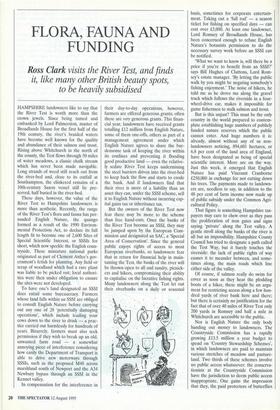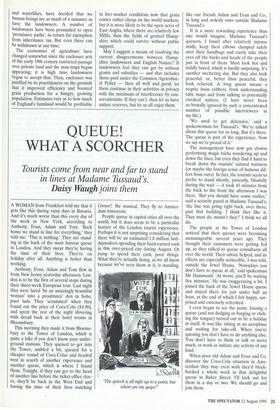FLORA, FAUNA AND FUNDING
Ross Clark visits the River Test, and finds
it, like many other British beauty spots, to be heavily subsidised
HAMPSHIRE landowners like to say that the River Test is worth more than the crown jewels. Since being tamed and embanked by Lord Palmerston, master of Broadlands House for the first half of the 19th century, the river's braided waters have become well known for the quality and abundance of their salmon and trout. Rising above Whitchurch in the north of the county, the Test flows through 50 miles of water meadows, a classic chalk stream which has never been made navigable. Long strands of weed still reach out from the river-bed and, close to its outfall at Southampton, the clinkered remains of a 10th-century Saxon vessel still lie pre- served, half buried in the river-bed.
These days, however, the value of the River Test to Hampshire landowners is more than aesthetic. Recently, the range of the River Test's flora and fauna has per- suaded English Nature, the quango formed as a result of the 1990 Environ- mental Protection Act, to declare its full length fit to become one of 2,600 Sites of Special Scientific Interest, or SSSIs for short, which now speckle the English coun- tryside. These miniature national parks originated as part of Clement Attlee's gov- ernment's fetish for planning. Any field or scrap of woodland which had a rare plant was liable to be picked out; local authori- ties were then under obligation to ensure the sites were not developed.
To have one's land designated an SSSI does entail some bureaucracy. Farmers whose land falls within an SSSI are obliged to consult English Nature before carrying out any one of 28 'potentially damaging operations', which include leading your cows down to the river to drink — a prac- tice carried out harmlessly for hundreds of years. Bizarrely, farmers must also seek permission if they wish to break up an old, unwanted farm road — a somewhat annoying piece of interference considering how easily the Department of Transport is able to drive new motorways through SSSIs, such as the proposed M48 across marshland south of Newport and the A34 Newbury bypass through an SSSI in the Kennet valley.
In compensation for the interference in their day-to-day operations, however, farmers are offered generous grants; often these are very generous grants. This finan- cial year, landowners have received grants totalling £12 million from English Nature, some of them one-offs, others as part of a management agreement under which English Nature agrees to share the bur- densome task of keeping the river within its confines and preventing it flooding good productive land — even the relative- ly sedate River Test keeps undermining the steel barriers driven into the river-bed to keep back the flow and starts to erode the bank. And if landowners find that their river is more of a liability than an asset they can, under the SSSI scheme, sell it to English Nature without incurring cap- ital gains tax or inheritance tax.
But the owners of the River Test now fear there may be more to the scheme than free hand-outs. Once the banks of the River Test become an SSSI, they may be jumped upon by the European Com- mission and designated an SAC, a 'Special Area of Conservation'. Since the general public enjoys rights of access to most European riverbanks, so landowners fear that in return for financial help in main- taining the Test, the banks of the river will be thrown open to all and sundry, picnick- ers and hikers, compromising their ability to capitalise on the lucrative fishing rights. Many landowners along the Test let out their riverbanks on a daily or seasonal basis, sometimes for corporate entertain- ment. Taking out a 'full rod' — a season ticket for fishing on specified days — can cost over £3,000. At least one landowner, Lord Romsey of Broadlands House, has been concerned enough to refuse English Nature's botanists permission to do the necessary survey work before an SSSI can be notified.
`What we want to know is, will there be a price if you're to benefit from an SSSI?' says Bill Hughes of Cluttons, Lord Rom- sey's estate manager. 'By letting the public walk by you might be negating somebody's fishing enjoyment.' The noise of hikers, he told me as he drove me along the gravel track which follows the riverside in a four- wheel-drive car, makes it impossible for game fishermen to stalk salmon and trout.
But is this unjust? This must be the only country in the world prepared to contem- plate establishing huge numbers of publicly funded nature reserves which the public cannot enter. And huge numbers it is: already, almost without any of us non- landowners noticing, 894,601 hectares, or 6.8 per cent of the land area of England, have been designated as being of special scientific interest. More are on the way. Just this week, it emerged that English Nature has paid Viscount Cranborne £250,000 in exchange for not cutting down his trees. The payments made to landown- ers are, needless to say, in addition to the 48 per cent of farm income now made up of public subsidy under the Common Agri- cultural Policy.
That figure is something Hampshire tax- payers may care to chew over as they pass the proliferation of iron gates and signs saying 'private' along the Test valley. A gentle stroll along the banks of the river is all but an impossibility. Hampshire County Council has tried to designate a path called the Test Way, but it barely touches the riverside: the lack of public rights of way causes it to meander between, and some- times along, the main roads which line either side of the valley.
Of course, if salmon really do swim for cover as soon as they hear the plodding boots of a hiker, these might be an argu- ment for restricting access along a few hun- dred yards of river bank here and there; but there is certainly no justification for the fact that of over 40 miles of River Test only 200 yards in Romsey and half a mile in Whitchurch are accessible to the public.
Nor is English Nature the only body handing out money to landowners. The Countryside Commission has a rapidly growing £13.5 million a year budget to spend on 'Country Stewardship Schemes', in which landowners are paid to maintain various stretches of meadow and pasture- land. Two thirds of these schemes involve no public access whatsoever: the conserva- tionists at the Countryside Commission have the jurisdiction to deem public access inappropriate. One gains the impression that they, the paid protectors of butterflies and waterlilies, have decided that we human beings are as much of a nuisance as have the landowners. A number of landowners have been persuaded to open `permissive paths', in return for exemption from inheritance tax. But even these can be withdrawn at any time.
The economics of agriculture have changed somewhat since the enclosure acts of the early 19th century restricted passage over private land and the man-traps began appearing; it is high time landowners began to accept that. Then, enclosure was justified by its practitioners on the grounds that it improved efficiency and boosted grain production for a hungry, growing population. Estimates vary as to how much of England's farmland would be profitable in free-market conditions now that grain comes rather cheap on the world markets, but it is more likely to be the open acres of East Anglia, where there are relatively few SSSIs, than the fields of genteel Hamp- shire which could survive without public support.
May I suggest a means of resolving the current disagreements between Hamp- shire landowners and English Nature? If landowners feel they can get by without grants and subsidies — and that includes those paid under the Common Agricultur- al Policy — then all well and good; let them continue in their activities in privacy with the minimum of interference by con- servationists. If they can't, then let us have nature reserves, but let us all enjoy them.



















































 Previous page
Previous page